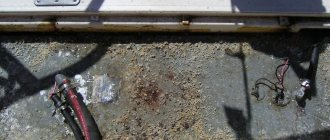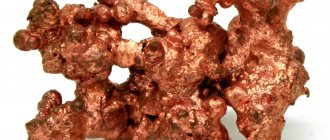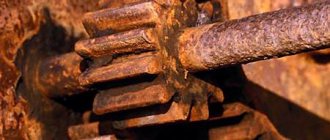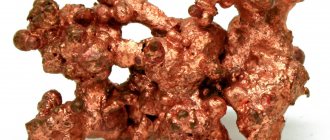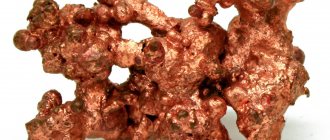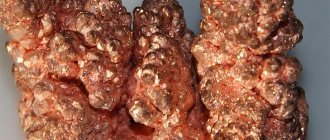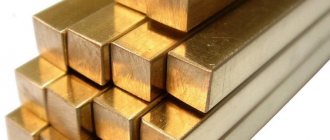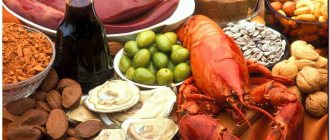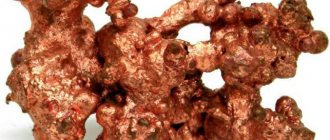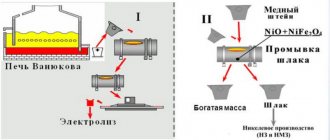Copper corrosion is the process of spontaneous destruction of this metal as a result of various types of environmental influences. Here it is impossible to apply such a concept as rusting, which is customary to describe this process with iron. The cause of corrosion of any metal is the thermodynamic instability of the material to the effects of active substances in the air. The rate of copper corrosion directly depends on temperature changes. When the temperature increases by 100 °C, the rate of reaction increases several times.
What is corrosion of metals and alloys
Corrosion refers to the process of destruction of metal under the influence of aggressive environmental factors. To one degree or another, all metals and alloys rust, as a result of which rust and areas of integrity damage (holes) appear on them. Non-metals can also deteriorate over time: an example is the aging of rubber or plastic from interaction with oxygen, frequent contact with water, and temperature changes.
The main cause of corrosion is considered to be the thermodynamic instability of the metal to the influence of physical factors or chemical substances that are present in the contact medium. Compared to iron, copper oxidizes much less, but with increasing temperature this process accelerates significantly. When regularly exposed to an environment with temperatures above +100 degrees, any metal rusts several times faster.
Solubility of copper in iron
As a result of this process, pseudo-alloys of Fe and Cu are formed. For metallic iron and copper, limited mutual solubility is possible. Its maximum values are observed at a temperature of 1099.85 °C. The degree of solubility of copper in the solid form of iron is 8.5%. These are small numbers. The dissolution of metallic iron in the solid form of copper is about 4.2%.
Reducing the temperature to room values makes the mutual processes insignificant. When metallic copper is melted, it is able to well wet iron in solid form. When producing Fe and Cu pseudo-alloys, special blanks are used. They are created by pressing or baking iron powder in pure or alloyed form. Such workpieces are impregnated with liquid copper, forming pseudo-alloys.
Corrosive properties of copper
Copper is a metal with high plastic properties, having a red-golden color, and after removing the oxide film - slightly pinkish. In terms of electrical conductivity, it is second only to silver, and is also characterized by high thermal conductivity. Due to its low resistivity, copper is used in electrical engineering: it is used to make copper plates, wires, and motor windings.
Due to its high anti-corrosion qualities, the metal is included in alloys to improve their technical characteristics (bronze, brass and others). In a galvanic environment, copper becomes a cathode, enters into electrochemical processes and causes accelerated rusting of other metals.
Copper is an inactive chemical element, therefore it practically does not interact with air or water (fresh, sea). If the air is dry, an oxide film up to 50 million thick is formed on the surface of the material. The copper product darkens, becomes brown or greenish, this is called patina. In some cases, patina is perceived as a decorative coating. The intensity of corrosion is low upon contact with dilute hydrochloric acid, but when reacting with a number of other acids, with halogens, and “regia vodka,” the metal is oxidized to form copper carbonate.
Solubility of copper in nitric acid
This reaction is possible due to the fact that the process of oxidation of the metal with a strong reagent occurs. Nitric acid in diluted and concentrated form exhibits oxidizing properties with the dissolution of copper.
In the first option, the reaction produces copper nitrate and nitrogen divalent oxide in a ratio of 75% to 25%. The process with dilute nitric acid can be described by the following equation:
In the second case, copper nitrate and nitrogen oxides are obtained, divalent and tetravalent, the ratio of which is 1 to 1. This process involves 1 mole of metal and 3 moles of concentrated nitric acid. When copper dissolves, the solution heats up strongly, resulting in thermal decomposition of the oxidizing agent and the release of an additional volume of nitrogen oxides:
The reaction is used in small-scale production associated with recycling scrap or removing coatings from waste. However, this method of dissolving copper has a number of disadvantages associated with the release of large amounts of nitrogen oxides. To capture or neutralize them, special equipment is required. These processes are very expensive.
The dissolution of copper is considered complete when the production of volatile nitrogen oxides completely ceases. The reaction temperature ranges from 60 to 70 °C. The next step is to drain the solution from the chemical reactor. At its bottom there are small pieces of metal that have not reacted. Water is added to the resulting liquid and filtered.
Material failure conditions
Despite their resistance to damage, even copper products can rust under certain conditions. Such phenomena are least expressed in humid air, water, soil, and more pronounced in an acidic environment.
Corrosion can be seriously reduced by tinning - coating copper with a layer of tin. High-quality tinning provides reliable protection from damage, increases corrosion resistance, and makes the material not susceptible to high temperatures, rain, hail, and snow. The service life of tinned products is more than 100 years without loss of original properties.
Water influence
The rate of copper corrosion in water strongly depends on the presence of an oxide film on its surface, as well as on the degree of oxygen saturation of the water. The higher the content of the latter, the more intense the destruction of the material occurs. In general, copper is considered resistant to the harmful effects of salt and fresh water, and is only adversely affected by dissolved chlorine ions and low pH levels. Strength and resistance to rust allows the material to be used for the manufacture of pipelines.
If there is a brown or green oxide crust on the surface of a copper-plated product, destructive substances penetrate inside to a small extent. Typically, the oxide layer forms after 60 days of the metal being in water. The green crust (carbonate) is considered more durable, while the black (sulfate) crust is loose and less strong.
In sea water the level of corrosion is almost the same as in fresh water. Only when the movement of the liquid accelerates does corrosion become impact, and therefore more intense. Copper is a material that is not capable of being overgrown by marine microorganisms, because its ions are destructive to mollusks and algae. This property of the metal is used in shipping and fishing.
Exposure to acids and alkalis
Copper does not deteriorate in alkalis, because the material itself is alkaline, but acids are the most harmful in terms of their effects. The most significant and rapid corrosion occurs upon contact with sulfur and its acidic compounds, and nitric acid completely destroys the structure of the material.
Copper dissolves in concentrated acids, so it requires additional protection when manufacturing equipment for the oil and gas industry. For this purpose, inhibitors are used to slow down chemical reactions:
- Shielding – form a film that prevents acids from reaching the copper surface.
- Oxidizing - convert the top layer into an oxide, which will react with acids without harm to the metal itself.
- Cathode - increase the overvoltage of the cathodes, thereby slowing down the reaction.
Corrosion in soil and moist air
The soil contains many microorganisms that produce hydrogen sulfide, so the environment here is acidic, and the rate of copper corrosion increases. The more the pH value deviates towards acidification, the faster the destruction processes occur. If the soil is saturated with oxygen, the metal oxidizes, but rusts less. When copper products are left in the ground for a long time, they turn green, become loose and may even crumble. Brief exposure to soil causes a patina that can be removed from the item.
Humid air has a bad effect on the condition of the material only with prolonged contact, and initially also causes the appearance of a patina (oxide layer). The exception is steam saturated with chlorides, sulfides, carbon dioxide - corrosion develops more rapidly in it.
Solubility in cast iron
In the structure of malleable pearlitic cast iron, in addition to the main components, there is an additional element in the form of ordinary copper. It is this that increases the graphitization of carbon atoms and helps to increase the fluidity, strength and hardness of alloys. The metal has a positive effect on the level of perlite in the final product. The solubility of copper in cast iron is used to alloy the original composition. The main purpose of this process is to obtain a malleable alloy. It will have increased mechanical and corrosion properties, but reduced embrittlement.
If the copper content in cast iron is about 1%, then the tensile strength is equal to 40%, and the yield strength increases to 50%. This significantly changes the characteristics of the alloy. Increasing the amount of metal alloying to 2% leads to a change in strength to 65%, and the fluidity rate becomes 70%. With a higher copper content in cast iron, spheroidal graphite is more difficult to form. The introduction of an alloying element into the structure does not change the technology for forming a viscous and soft alloy. The time allotted for annealing coincides with the duration of such a reaction in the production of cast iron without copper admixture. It is about 10 hours.
Read also: Seg80 4c connection diagram
The use of copper for the production of cast iron with a high silicon concentration is not able to completely eliminate the so-called ferruginization of the mixture during annealing. The result is a product with low elasticity.
Why copper products need to be cleaned regularly
Copper pots, ladles, and samovars are distinguished by high thermal conductivity, so heating in them proceeds evenly and food cooks faster. This determines the high popularity of products in everyday life. The need to clean copper objects is due to their loss of visual appeal over time. Products that are exposed to air or frequently heated up fade and lose their natural color especially quickly.
Oxide film - patina - is popular only where it is required to give things a vintage look, antique stylization. Otherwise, it spoils the appearance of dishes, utensils, jewelry and figurines. To remove oxide deposits, darkening elements and restore shine, you will have to periodically clean the items. Cleaning is also required to prevent harmful compounds that may be present in the black or green layer from getting into the food.
Exposure to soil and moist air
Corrosion of copper in the soil is mainly caused by the influence of acids contained in the soil. Compared with the effects of water, oxygen in the soil oxidizes metal elements much less. The most dangerous microorganisms in the soil are, or rather, their secretions. They are often capable of releasing hydrogen sulfide, which destroys metal. Thus, copper lying in the soil for a long time can completely decompose.
In humid air the process does not proceed rapidly. It takes a long time. In a dry climate, destructive effects may not be observed at all. This is explained by the fact that in humid air there is a high concentration of carbon dioxide, sulfides, chlorides, which cause corrosion and are destructive to the protective film.
Prolonged exposure to humid air can cause the formation of a patina layer. This is the name given to green deposits on copper. It consists of salt oxides, which are initially dark brown in color, and then the surface begins to turn green. The peculiarity of patina is that it cannot be dissolved in water and is not affected by high air humidity. It has neutral properties to copper itself, which allows it to protect the surface from the harmful effects of the environment. In addition, modern methods of creating artificial patina make it possible to use it in objects of art and during restoration.
Effective Copper Cleaning Methods
Cleaning copper items is easy and does not require expensive products. Here are the most popular techniques used at home:
- Ketchup. Take a little tomato ketchup, lubricate the product with it, and leave for two minutes. Then rinse with running water.
- Dishwashing solution. Lather a household sponge with regular dish soap, wipe the surface thoroughly, and rinse with water. This method is best for items that are only slightly faded.
- Lemon. Rub the copper surface with a slice of lemon, then go over it with a stiff bristled brush and wash with water.
- Vinegar and flour. Pour a little vinegar into a cup, add flour until you get a medium-thick dough. Lubricate the copper with the dough, leave until dry, then remove the residue and rub the product with a soft cloth.
- Vinegar and salt. Pour 9% vinegar into a stainless steel pan, add a little salt, and let it boil. Turn off the heat, put a copper object into the solution, do not remove it until the liquid cools. This method is suitable for heavily soiled surfaces.
Corrosion of tinned copper
Tinned copper has excellent corrosion resistance. Tinned copper serves well even under the influence of rain, hail, snow, and is not sensitive to changes in ambient temperature. Atmospheric corrosion of tinned copper is very negligible. The tin coating is an anode in relation to copper, because has a more electronegative potential. If there are no flaws on it (pores, cracks, scratches) through which copper comes into contact with the atmosphere, it will last a very long time. If coating defects are present, atmospheric corrosion of tinned copper proceeds through the following reactions:
A: Sn – 2e→ Sn 2+ – oxidation of tin;
K: 2 H2O + O2 + 4e → 4 OH – – reduction of copper.
High-quality tin plating extends the life of tinned copper to 100 years or more.
Cleaning Copper Coins
Copper coins are antiques and are not issued in modern times. They often have to be cleaned to restore their attractive appearance. If the coin has been in contact with lead, the coating may be yellowish. In this case, it can be easily cleaned with table vinegar (9%). Green plaque is removed with a solution of citric acid (10%) or lemon juice, brown plaque is removed with ammonia or ammonium carbonate.
It must be remembered that sometimes a layer of patina gives coins a more noble and vintage look, so it is not always advisable to remove it. Some, on the contrary, try to artificially age money at home. To do this, you need to take a liter of distilled water, 5 g of pharmaceutical potassium permanganate, 50 g of copper sulfate. Heat the solution without boiling, throw coins into it, and leave until the desired shade is achieved. To consolidate the effect, treat dried money with a mixture of benzene and alcohol (1:1). Afterwards, the coins will acquire a beautiful aged appearance and will be able to decorate any collection of antiques.
Solubility in mercury
When mercury is mixed with metals of other elements, amalgams are obtained. This process can take place at room temperature, because under such conditions Pb is a liquid. The solubility of copper in mercury disappears only during heating. The metal must first be crushed. When solid copper is wetted with liquid mercury, mutual penetration of one substance into another or a process of diffusion occurs. The solubility value is expressed as a percentage and is 7.4 * 10 -3. The reaction produces a hard, simple amalgam similar to cement. If you heat it up a little, it softens. As a result, this mixture is used to repair porcelain products. There are also complex amalgams with an optimal content of metals. For example, dental alloy contains the elements silver, tin, copper and zinc. Their percentage ratio is 65: 27: 6:2. Amalgam with this composition is called silver. Each component of the alloy performs a specific function, which allows you to obtain a high-quality filling.
Another example is an amalgam alloy, which has a high copper content. It is also called copper alloy. The amalgam contains from 10 to 30% Cu. The high copper content prevents the interaction of tin with mercury, which prevents the formation of a very weak and corrosive phase of the alloy. In addition, reducing the amount of silver in a filling leads to cheaper prices. To prepare amalgam, it is advisable to use an inert atmosphere or a protective liquid that forms a film. The metals that make up the alloy can be quickly oxidized by air. The process of heating cuprum amalgam in the presence of hydrogen causes the mercury to be distilled off, allowing the elemental copper to be separated. As you can see, this topic is not difficult to learn. Now you know how copper interacts not only with water, but also with acids and other elements.
Atmospheric corrosion of copper
Under atmospheric conditions, copper is highly resistant to corrosion. In dry air, the surface of copper remains almost unchanged. And upon contact with moist air, an insoluble film is formed, consisting of copper corrosion products such as CuCO3•Cu(OH)2.
Depending on the composition of the environment and many other factors, a very thin protective film consisting of copper oxides and pure copper oxide is first formed on the copper surface in the atmosphere. The formation time of this film can reach several years. The surface darkens a little and becomes brownish. Sometimes the film can be almost black (largely depends on the composition of the corrosive environment). After the formation of the oxide layer, copper salts with a greenish tint begin to accumulate on the surface. The resulting oxide of copper and salt is also called patina. The color of the patina ranges from light brown to black and green. Depends on the quality of surface treatment, the composition of the metal itself and the environment, the time of contact with the corrosive environment (from internal and external factors). Copper oxide is red-brown in color, copper oxide is black. Blue, green, blue and other shades of patina are caused by various copper minerals (sulfates, carbonates, chlorides, etc.). Patina is neutral in relation to the base metal, i.e. does not have a harmful effect on copper (except copper chloride). Salts and oxides that form patina are insoluble in water and have natural decorative and protective properties in relation to the copper surface.
The presence of carbon dioxide in humid air leads to the formation of a mixture on the surface, which is also called malachite. Sulfides and chlorides in the air destroy malachite. This accelerates atmospheric corrosion of copper.
Why copper rusts and how to protect it from corrosion
Copper products have been used by humans for several centuries. In pre-revolutionary times, the price of this metal was equal to the cost of gold, its production was so expensive. Now copper has become much cheaper, so in addition to jewelry, it is used to make dishes, interior accessories and other items.
Corrosion of copper, unlike iron, develops slowly due to its resistance to this phenomenon, and yet sometimes it is necessary to take measures to clean products from unsightly plaque.
Use of ammonia
Of all the products presented, ammonia is the most caustic substance, but it can age copper best of all and gives a brownish-green patina. The disadvantage of using this product is that this gas evaporates, which is why it needs to be treated more often than with other substances. To use this method you will need: ammonia itself without impurities, a sealed plastic bucket, small wooden blocks.
Patination or aging of copper coins
The ammonia application method consists of the following steps:
- Place the bars at the bottom of the bucket so that you get a small but stable platform;
- pour ammonia into the bucket without bringing its level to the upper surface of the platform;
- place the copper product on the wooden structure so that it holds firmly on the platform. If it falls from it, then you just need to take it out, rinse it with water and place it again on the bars;
- Close the bucket tightly and check readiness every hour. The procedure usually takes several hours. While checking the appearance of the desired shade, do not inhale ammonia vapor.
Drying, as with other methods, is a mandatory and final stage of aging. You can dry it naturally, without using a hair dryer or other hot methods.
It is not worth covering the product with varnish, since you will have to periodically remove it, because, as mentioned above, treatment with ammonia is carried out many times during the use of the copper item.
Using a ready-made aging solution
This method is the fastest, since the product itself does not need to be prepared independently; it is sold ready-made. Since the aging solution contains substances that are harmful to the skin, do not forget to wear gloves and safety glasses.
Brass Black Metal Finish for aging copper, manufactured by the American company Birchwood Casey
Different solutions may have different information about the quantities in which the liquid should be diluted, but you should always follow the instructions that are indicated on the label of the purchased product.
When the preparatory processes are completed, you can begin to process the copper product. To do this, you need to lower the copper item into the solution several times at different angles so that the entire surface of the item is covered with the product. It is necessary to ensure that there are no bubbles, since then light spots may remain in their place.
You should repeat this procedure until you get the desired color. Overexposure or, conversely, raising the product from the solution too early is not a problem, since during overexposure you can treat it with a scraper, and if the desired color is not achieved, lower it into the product again. At the end of the process, the copper must be dried and varnished if the achieved result is to be secured.
